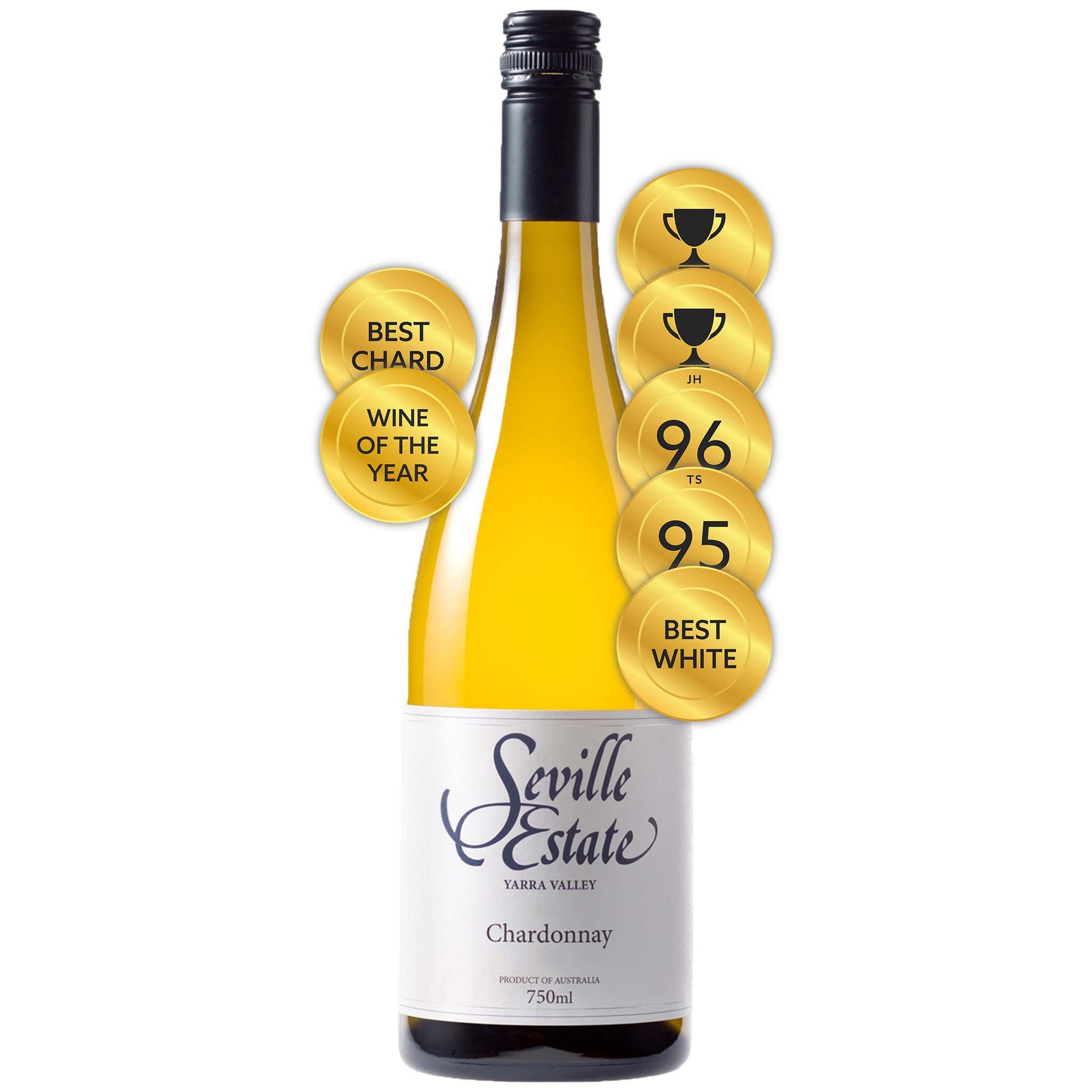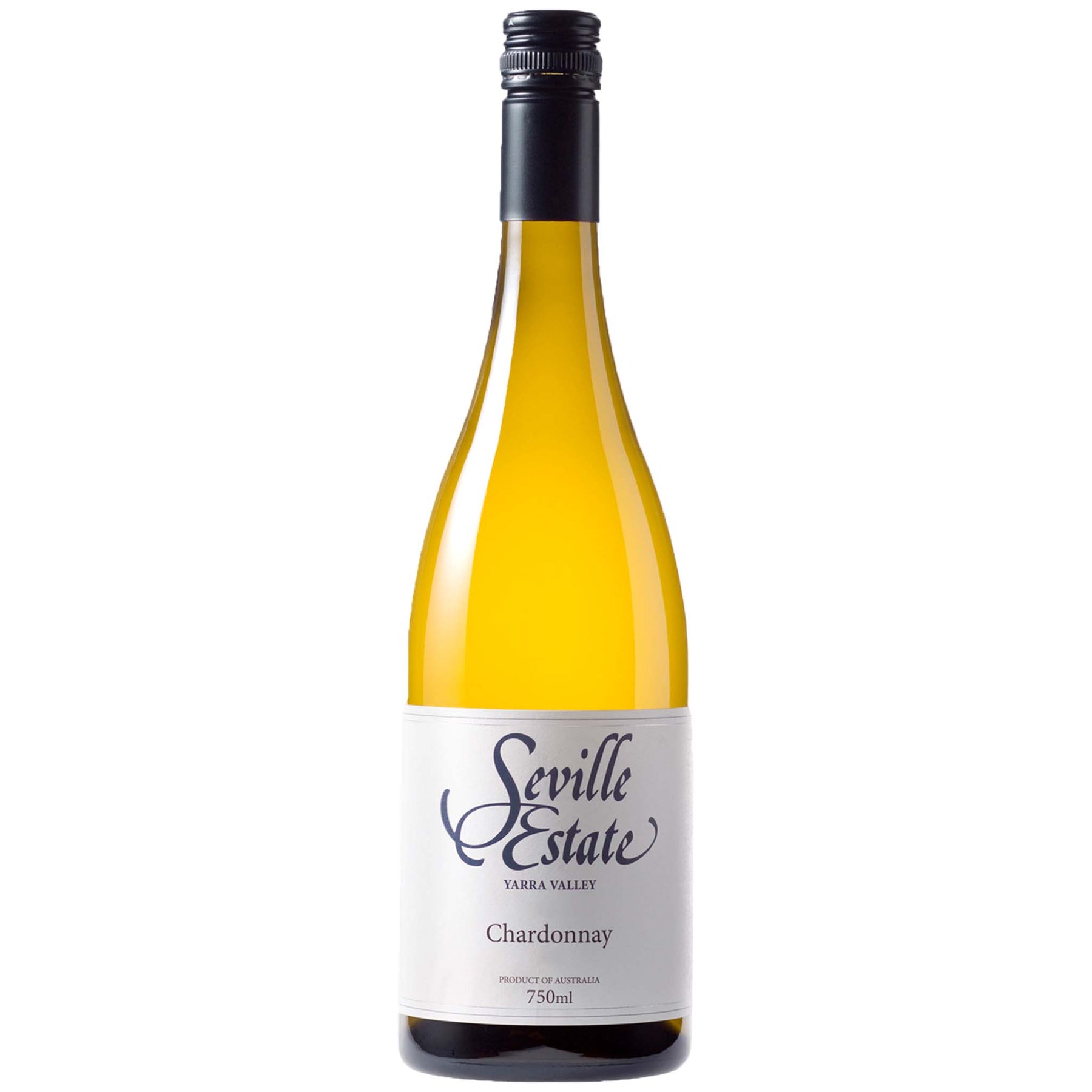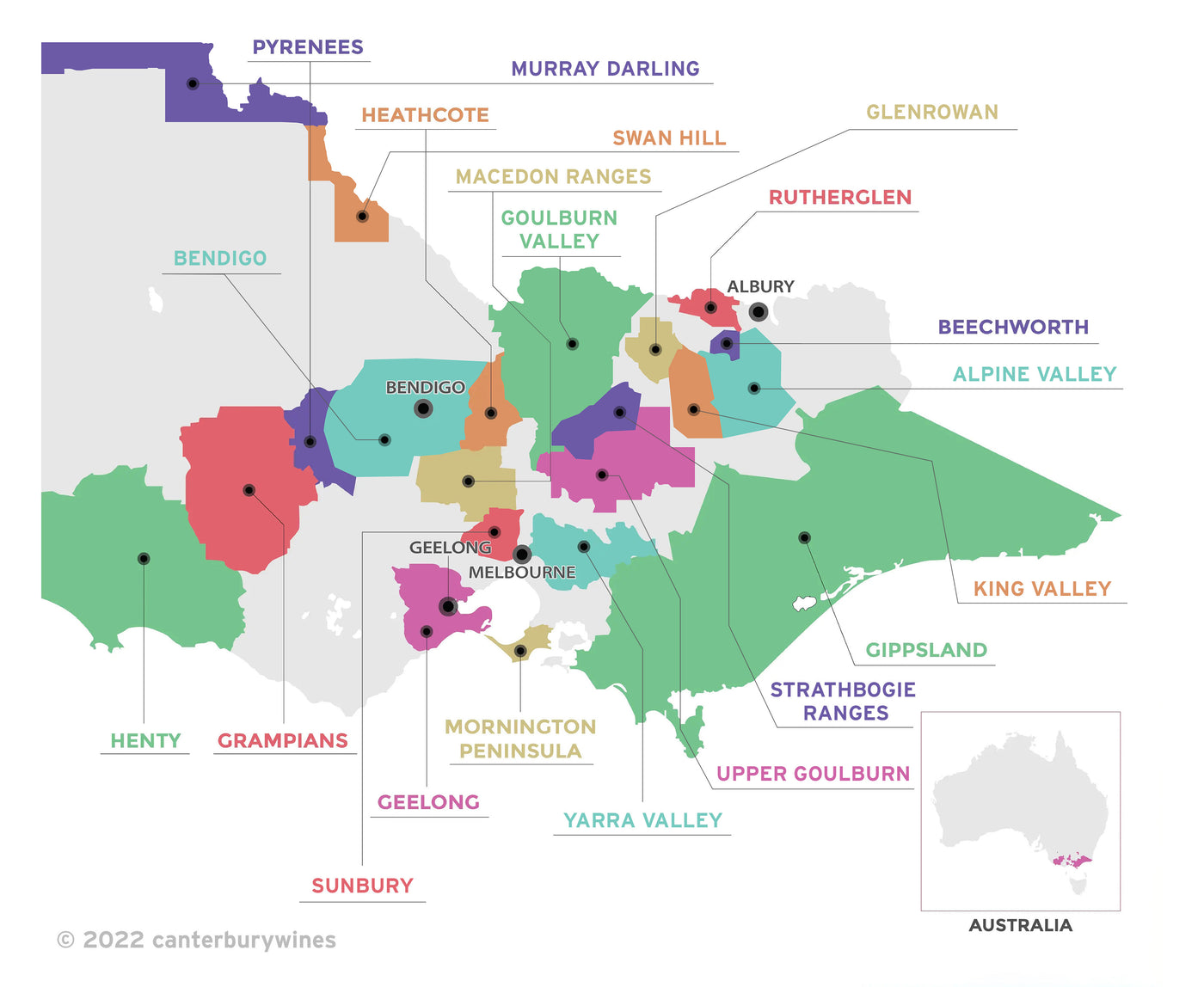

Seville Estate Chardonnay 2010
Style: White Wine
Closure: Screwcap
Seville Estate Chardonnay 2010
Warehouse
34 Redland Drive
Vermont VIC 3133
Australia
Producer: Seville Estate
Country: Australia
Region: Yarra Valley
Vintage: 2010
Critic Score: 96
Alcohol: 13.0%
Size: 750 ml
Drink by: Now
Wine of the Year - 2012 Fed Square Wine Awards
Trophy for Best White Wine in Show - 2011 Yarra Valley Wine Show
Trophy for Best Chardonnay - 2011 Yarra Valley Wine Show
Best White Wine - 2012 Fed Square Wine Awards
Best Chardonnay - 2012 Fed Square Wine Awards
Seville Estate, located at the southern end of the Yarra Valley, was established in 1972 by Dr Peter McMahon and his wife Margaret. It is one of the Valley’s oldest and most important vineyards and was named Winery of the Year at the 2019 Halliday Wine Companion Awards - a testament to grandson Dylan McMahon who has been Seville's winemaker since 2004.
"Seville Estate is one of the mainstays of Upper Yarra viticulture, and the outstanding 2010 vintage has elevated its Estate Chardonnay to new heights of textural minerality, seamless precision, pristine fruit clarity and expertly crafted styling. Pure, focused and fresh grapefruit and white peach are beautifully integrated with cashew nut French oak, finishing with outstanding persistence." Tyson Stelzer
Seville Estate - Halliday Winery of the Year 2019
Expert reviews
"This is a highly expressive and savoury wine, showing charcuterie, pear, citrus blossom and a touch of spicy oak; the palate is linear, pure, racy and enthralling, leaving a trail of broken hearted taste buds in its wake; truly expansive and expressive, if you need to be convinced of the Yarra's suitability for chardonnay, this may be the wine you simply have to try. 13% alcohol. Drink by: 2020." James Halliday - 96 points
"This was a hotly contested class; the winning chardonnay showed elegance and restraint with a good backbone of acid. Clean, fresh and lifted with lively citrus notes. A lovely example of the new style chardonnay with restraint." Victoria Sharples (Panel Judge), 2012 Fed Square Wine Awards - Wine of the Year, Best White Wine and Best Chardonnay
"Seville Estate is one of the mainstays of Upper Yarra viticulture, and the outstanding 2010 vintage has elevated its Estate Chardonnay to new heights of textural minerality, seamless precision, pristine fruit clarity and expertly crafted styling. Pure, focused and fresh grapefruit and white peach are beautifully integrated with cashew nut French oak, finishing with outstanding persistence." Tyson Stelzer, Wine Taste - 95 points
Awards
Trophy for Best White Wine in Show - 2011 Yarra Valley Wine Show
Trophy for Best Chardonnay - 2011 Yarra Valley Wine Show
Wine of the Year - 2012 Fed Square Wine Awards
Best White Wine - 2012 Fed Square Wine Awards
Best Chardonnay - 2012 Fed Square Wine Awards
Dylan McMahon

Dylan McMahon now helms the estate planted by his grandfather in the 1970s. Seville Estate may not be family-owned anymore, but McMahon is the respectful custodian of that family history, with an unwavering eye to carrying the estate name forward to even greater heights. With a natural focus on the regional stars, chardonnay and pinot noir, Seville is one of the early champions of shiraz, and still one of the Yarra’s top exponents. McMahon was a three-time Young Gun of Wine Finalist, in 2011, ’12 and ’14.
Seville Estate is one of the Yarra Valley’s oldest and most important vineyards, being planted by Dr Peter McMahon in 1972. It wasn’t the first vineyard planted after economic decline saw a once rich viticultural area wiped out, but it was in a small clutch of now iconic names that have defined the region.
Dylan McMahon is the grandson of Dr McMahon, but his is no straight story of a generational winemaking dynasty. His grandfather had retired in 1996 and decided to sell the estate the same year. Brokenwood was the buyer then, though it has since been sold and bought a couple more times, and never back into family hands. Indeed, Dylan took on a role at the winery in 1999 to save some money while on deferment from an electrical engineering degree, rather than to fulfill any winemaking ambitions.
Alastair Butt, winemaker at Seville Estate at the time, recalls that "Dylan came to me and said, can I come and work vintage with you? So, he became my assistant winemaker, helped out in the vineyard, did a vintage at Brokenwood."
"I thought, this is great," says Dylan. "As a winemaker you’re doing all types of things, going out picking fruit, coming in getting your hands dirty, stomping, jumping into vats. And there seemed to be this work-hard-play-hard type of ethic that resonated with me. So I ended up switching degrees and switching careers."
Dylan enrolled in a wine science degree at Charles Sturt University and travelled to gain more worldly experience. That degree was finally finished in 2008, but he had worked vintages at Brokenwood, Hugel & Fils, Domaine Paul Blanck and Jean Claude Boisset before graduating. He also took on the Chief Winemaking role at Seville in 2004 after Alastair Butt left to start something else. There were a few bumpy vintages after that, he says, but from 2008, he started to feel comfortable in the role.
McMahon credits Brokenwood’s Iain Riggs as a key mentor along with Alistair Butt, but the guidance of his grandfather from those early years has also been indelible. "My grandfather was a great influence, he taught me about the discipline and the focus of winemaking," he says. "He would pick me up on the smallest details, like how to roll a hose or clean the floor. At the time, I thought he was just really hard to work with but now appreciate what he was trying to teach me."
Along with the Seville wines, McMahon makes wines under the Burton McMahon banner with his good friend Matt Burton of the Hunter Valley’s Gundog Estate, turning out multiple site-specific expressions for the Yarra Valley and Gippsland.
"I love making wines from the Yarra Valley, the diversity of varieties and subregions make it really interesting," says McMahon. "This is not to say I don’t like making wines from other regions, far from it. Having the opportunity to focus in on a region and learn about the detail and how it translates to wine style has been fascinating."
Today, Dylan is Chief Winemaker and General Manager of Seville Estate, with new ownership allowing it to expand and replant to mitigate the effects of encroaching phylloxera, a process that he sees as one that needs to embrace the legacy of his grandfather. The estate has expanded to encompass the neighbouring vineyard and property (formerly Ainsworth Estate). This extra land has allowed for replanting original vine material grafted onto rootstock to preserve the original '72 clones and safeguard the future of this unique property.
"Replanting continues to be a focus for Seville Estate, grafting the old vines onto new American rootstock is a long-term process. Preserving the original vine material for the future is extremely important to our wine style and for the continuation of our history and story."
That original vine material contributes to one of the Yarra’s most distinct expressions of shiraz, sourced from the original 1972 plantings and bearing the name of Seville’s founder. The wine, the Seville Estate Dr McMahon Shiraz, was first made in 2010 as a tribute to his grandfather and released a couple of years later to coincide with the 40th anniversary of the vineyard. Dylan says he wanted to make a wine that expressed Pete’s attention to detail – but in a way that would also gently take the mickey out of his grandfather.
"Making it the most absurd way seemed appropriate," he says, smiling. "Hand-picked, and then 100 per cent whole bunches, hand-loaded into barrels for fermentation. All techniques he would have hated." Dylan let the wine ferment naturally, too, using wild yeasts, which Pete, being a GP and understanding the microbiology, would have considered 'the devil’s work'. He knew his grandfather would disapprove of all this, so Dylan kept the wine secret. But eventually, once it was safely in bottle, he showed it to Pete.
"And he loved it," says Dylan. "Then I told him how it was made. And his eyes were wide open, and he thought it was extraordinary. But I think the biggest thing that touched him was the fact that we named the wine after him."
In the last ownership change of Seville Estate, Yiping Wang purchased the property in early 2017. Yiping’s supportive yet hands-off approach has allowed Dylan to steer the ship.
"The quality of the wines and the success of Seville Estate is a team effort," he says. "And we’ve got the best team that Seville has ever had at the moment. Everyone’s really passionate and shares the same vision for making the best wines that we can from this site. The idea that there’s only one person at the centre of it all – for me, that’s bullshit. If you surround yourself with really good people, good things will come out of it."
"The big focus will be on the vineyard for the next ten years, to ensure the longevity of Seville Estate," says Dylan, "And I’d hope that in 50 years’ time, people are talking about what we’re doing here now."
The above text is taken from an article on Dylan McMahon that appeared in Young Gun of Wine and from Fifty Years of "Excellent Booze" – a history of Seville Estate by Max Allen
About the winery

Seville Estate, established in 1972 by Dr Peter McMahon and his wife Margaret, is one of the Yarra Valley’s oldest and most important vineyards. Together with other producers such as Mount Mary, Yeringberg, Yarra Yering and St Huberts, it played a leading role in the renaissance of the Valley. The area had enjoyed a reputation as a premium wine-producing region in the 19th century, but the onset of the Great Depression, the increasing popularity of fortified wine and the emerging profitability of dairy farming saw wine production cease in the 1920s.
Seville Estate is located at the southern end of the Yarra Valley on very red volcanic soils over clay, miles from where those other new vineyards were – near Coldstream and Healesville. "Pete wanted to plant grapes in that Coldstream area, but he didn’t have the money, so he had to venture further out. It would have been a gutsy move, to come out here, which was cooler than Coldstream, higher rainfall, less likely to ripen the varieties that everyone was planting, like cabernet," says his grandson Dylan, who is now Chief Winemaker and General Manager at Seville Estate.
What also sets this cooler, wetter area of the valley apart is its deep red soils. Dylan says that his grandfather was attracted to those soils – they are a striking feature of the landscape as you drive or walk through it – but was nervous about them. Conventional viticultural wisdom is that, when it comes to growing grapes, the poorer the soils, the better. Would Seville be too fertile, too rich?
The McMahons originally planted 1000-or-so vines on the red soils. The varieties are listed in Peter's diary: chardonnay, riesling, shiraz, pinot noir and cabernet sauvignon. "Pete loved everything about wine and so he wanted to plant everything," says Dylan. "Riesling because he loved German rieslings. Shiraz because he loved northern Rhone. He wanted to make left bank Bordeaux blends, he wanted to make burgundy. He wanted it all, so he basically planted it all to see what worked and what didn’t. And remarkably, they all worked."
In 1983, Pete McMahon took on a young winemaking student, Alastair Butt, to help him out at Seville Estate. "We got on really well," says Alastair. "Pete had very high standards – you always felt he was watching over your shoulder – but I helped introduce some things I’d learned from Uni, like proper analysis of wine. I was young and enthusiastic."
The wines Pete and Alastair made in the 80s and 90s cemented Seville Estate’s reputation. Surprisingly, in a region more renowned for Cabernet, Pinot Noir and Chardonnay, it was the Seville Estate Shiraz that received the most attention, becoming one of Victoria's most sought after wines. "One of my earliest 'a-ha' moments as a young newbie in the wine world was tasting the 1985 shiraz, a wine with amazing seductive complexity," says Alistair. "That was a ripper of a year, and I was far from alone in being seduced by the bottles emerging from these red soils."
In 1996, Pete McMahon retired and decided to sell the estate. The iconic Hunter Valley winery Brokenwood became the majority shareholder in Seville Estate in 1977 and took full control a couple of years later. They expanded the vineyard, re-designed the labels, and introduced new wines to the range made from bought-in fruit.
In 1999, grandson Dylan McMahon took on a role at the winery to save some money while on deferment from an electrical engineering degree. Alastair Butt recalls that "Dylan came to me and said, can I come and work vintage with you? So, he became my assistant winemaker and helped out in the vineyard."
"I thought, this is great," says Dylan. "As a winemaker you’re doing all types of things, going out picking fruit, coming in getting your hands dirty, stomping, jumping into vats. And there seemed to be this work-hard-play-hard type of ethic that resonated with me. So I ended up switching degrees and switching careers." Dylan enrolled in a wine science degree at Charles Sturt University and travelled to gain more worldly experience. He worked vintages at Brokenwood, Hugel & Fils, Domaine Paul Blanck and Jean Claude Boisset before graduating. Dylan also took on the Chief Winemaking role at Seville in 2004 after Alastair left.
In late 2005, Seville Estate changed hands again when Brokenwood sold the business to a wine-loving Brisbane couple, Graham and Margaret Van Der Meulen, bringing it back into family ownership. The new owners brought back the old label design and re-focused on the estate vineyards, investing in the winery and building a new cellar door and restaurant.
In the last ownership change of Seville Estate, Yiping Wang purchased the property in early 2017. Yiping’s supportive yet hands-off approach has allowed Dylan, who became General Manager in addition to Chief Winemaker, to steer the ship.
"As the head winemaker, I’ve been really focused on trying to make the best wines possible from this vineyard," says Dylan. "In my new role as GM, together with new ownership, I now have access to some capital funds that I can use to implement some changes and improvements to the property. This has enabled us to modernise and expand our offering, which has allowed us to reach our potential as a company. In the last 12 months, we’ve put together a whole new team of people coming into the business – we’ve grown from a company with three employees to now having a team made up of nine full-time staff and 12 casuals – we’ve opened a restaurant, expanded our accommodation, including the renovation of the old homestead. It’s exciting – the place is filled with all these really talented people now, who are all experts in their field, which is really inspiring."
"We’ve also expanded the vineyard, which is vital," he adds. The estate has expanded to encompass the neighbouring vineyard and property (formerly Ainsworth Estate). This extra land has allowed for replanting original vine material grafted onto rootstock to preserve the original '72 clones. "Replanting will continue to be the big focus for Seville Estate, as grafting the old vines onto new rootstock is a long-term process. Preserving the original vine material for the future is extremely important to our wine style and for the continuation of our history and story."
Seville Estate was named Winery of the Year at the 2019 Halliday Wine Companion Awards. Halliday explains what it was about the Seville wines – particularly the shiraz – that particularly impressed him. "It’s the brightness," he says. "The length of flavour. The subdued but terribly important role that tannins play in the overall balancing structure of the wine. The vivid nature of the aromas and flavours mean you don’t have to work on a glass of shiraz from that vineyard to start smiling."
For Dylan, this award was a testament to the 'gutsy move' that Pete and Marg made in choosing the site in 1971, and all the hard work that had gone into it over the decades. For the current owner, Yiping Wang, the accolade was also a huge vindication.
Sections of the above text are taken from Fifty Years of "Excellent Booze" – a history of Seville Estate by Max Allen

Dr Peter McMahon and grandson Dylan McMahon share a drop Photo: Meredith O'Shea

Victoria
Victoria is home to more than 800 wineries across 21 wine regions. The regions are Alpine Valley, Beechworth, Bendigo, Geelong, Gippsland, Glenrowan, Goulburn Valley, Grampians, Heathcote, Henty, King Valley, Macedon Ranges, Mornington Peninsula, Murray Darling, Pyrenees, Rutherglen, Strathbogie Ranges, Sunbury, Swan Hill, Upper Goulburn and Yarra Valley.
Victoria's first vines were planted at Yering in the Yarra Valley in 1838. By 1868 over 3,000 acres had been planted in Victoria, establishing Victoria as the premier wine State of the day. Today, the original vineyards planted at Best's Wines are among the oldest and rarest pre-phylloxera plantings in the world.
Victoria's climate varies from hot and dry in the north to cool in the south and each wine region specialises in different varietals. For example, Rutherglen in the north is famous for its opulent Muscats and Topaque and bold reds, while the many cooler climate regions near Melbourne produce world class Chardonnay and pinot Noir. Victoria is truly a wine lover's playground.

